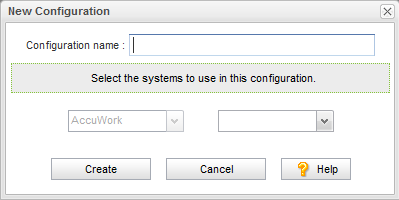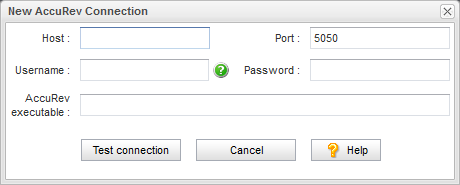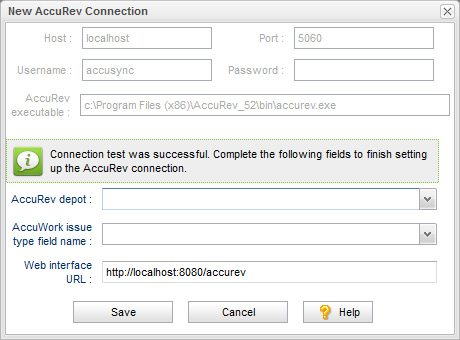Creating the AccuWork and ITS Connections
This procedure describes how to create the connection components AccuSync uses to connect to AccuWork and your ITS. In addition to connection information, you use the connection components to specify:
- The AccuRev depot and ITS projects whose issues you want AccuSync to synchronize.
- The name of the AccuWork schema field that stores the type of issue (defect or task, for example) AccuSync will synchronize
To create the AccuRev and ITS connections:
-
Verify that the AccuSync Server is running. See AccuSync Service if you need help with this step.
-
Verify that your ITS service is available. Depending on your ITS, this might involve ensuring that a server is running or simply checking that your cloud-based ITS is not down for maintenance, for example.
-
Start the AccuSync Management Console. See Start the AccuSync Management Console if you need help with this step. The AccuSync Management Console main page appears. Any existing configurations are displayed in the Configurations table.

-
Click the Add new... button. The New Configuration page appears.

-
Enter the Configuration name.
-
Select the system you are synchronizing with AccuWork.
-
Click the Create button.
The New AccuRev Connection dialog box appears.

-
Specify the values required to connect to AccuWork. Note the following:
Host The name of the machine hosting the AccuRev Server. localhost, for example. Port
The port used to connect to AccuRev. Username
The name of the AccuSync user. See Create the AccuSync User. Password The password associated AccuSync user.
AccuRev executable The full path of the AccuRev executable (accurev.exe). This is typically in the \bin directory where you installed AccuRev. -
Click the Test Connection button.
When the connection succeeds, a new panel appears on the New AccuRev Connection dialog box that allows you to specify the AccuRev depot whose issues you want to synchronize with your ITS projects.

-
Complete the remaining fields as follows:
AccuRev depot
The name of the AccuRev depot whose issue records you want to synchronize with your issue tracking system (ITS).
Note: This field appears only after you test the connection.
Tip: When you select a depot, a default value appears in the AccuWork Issue Type Field Name field.
AccuWork issue type field name
Tip: When you select a depot, a default value appears in the AccuWork Issue Type Field Name field.
AccuWork issue type field name.
AccuWork issue type field name The internal name of the field that displays the issue type (defect, task, and so on) on the AccuWork Issue Edit Form. Unless you have changed the name in the AccuWork schema, the name of this field is type.
Note: This field appears only after you test the connection.
Web interface
The URL for the machine hosting the AccuRev Web Interface. For example: http://localhost:8080/accurev/.
Note: This field appears only after you test the connection.
-
Click Save.
The New Connection dialog box appears. You use this dialog box to specify connection settings for your ITS.
Note: Fields on the Edit Connection dialog box vary slightly based on ITS.
-
Specify the values required to connect to your ITS. See New ITS Connection Dialog Box if you need help with this step.
-
Click the Test Connection button.
When the connection succeeds, new panels appear on the New Connection dialog box. Fields on this panel vary slightly based on your ITS.
Note: For JIRA users: If the connection to JIRA does not succeed, make sure that the JIRA plugin for AccuSync was installed and that JIRA has been configured to accept remote API calls. See Configure JIRA for AccuSync for more information.
-
Click Save.
AccuSync displays a message indicating that the configuration was created successfully.
-
Click OK to clear the message.
The new configuration appears in the Configurations table on the AccuSync Management Console main page.











